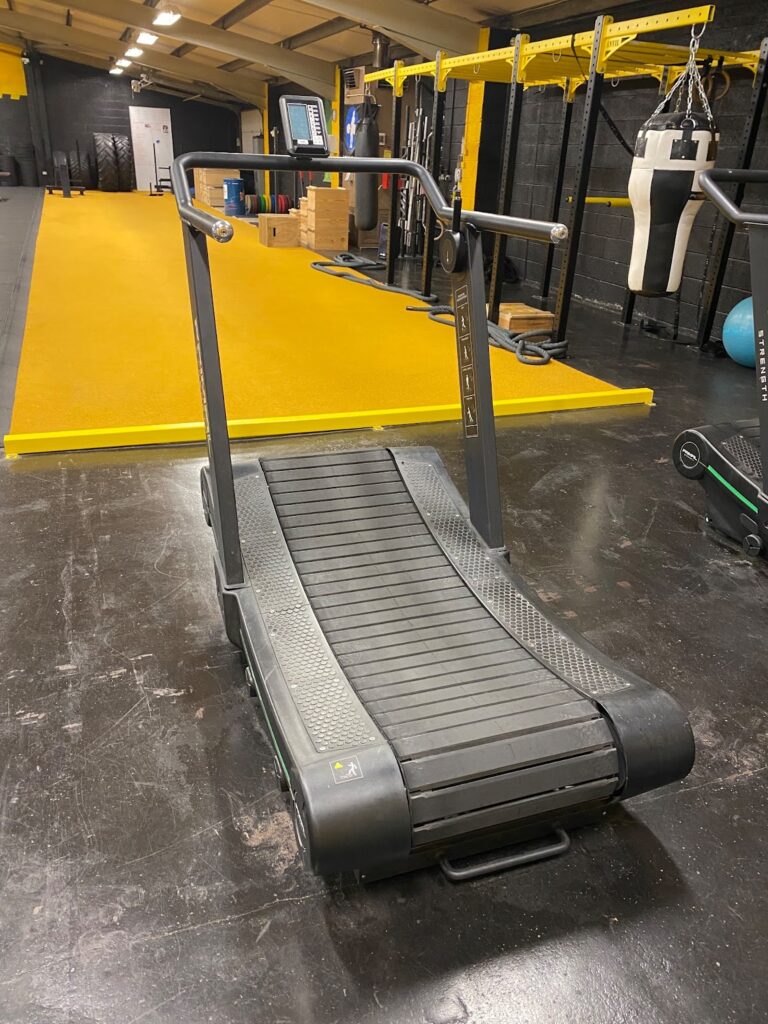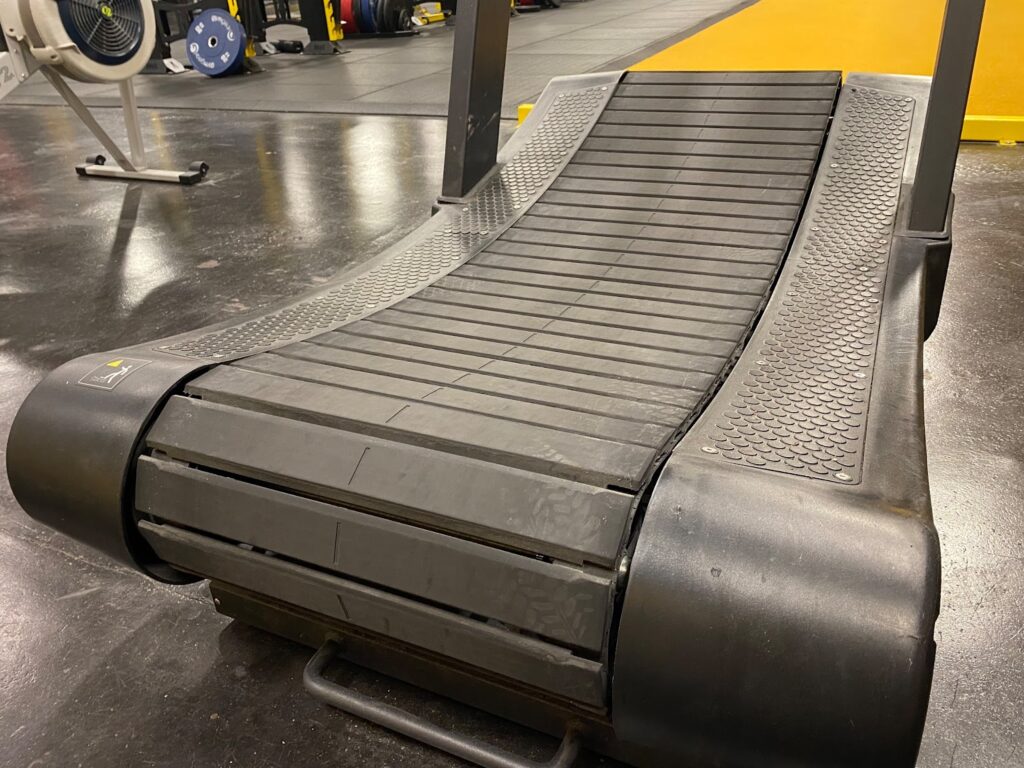Over the last decade or so the treadmill market has transformed. Technology has improved, making treadmills more interactive. You can have a video screen to watch movies on as you run. You can even ‘run around’ various locations across the globe!
These are great for preventing boredom, but the most important innovations? Well, they’re underfoot… the rise of the slat treadmill has been the biggest innovation in treadmill functionality and performance in decades.
The first commercial grade treadmills hit the wider market in the 1980’s. Ever since, the flat belt has been the go-to treadmill technology.
Woodway claims the idea for the slat belt treadmill was born in 1974. In reality they didn’t become a mainstream feature until the post 2000 fitness boom. Now though, they’re very popular – especially in CrossFit boxes and strength and conditioning facilities.
In this article we’re going to look at slat treadmill vs belt treadmills. There’ll be the pros and cons of each, and advice on which one to buy and why.
Jump to:
What is a slat belt treadmill?

A slat belt treadmill is a treadmill where the running surface consists of lots of individual ‘slats’ joined together to form the belt. The slats are usually either made of wood or rubber. Slat belt treadmills are non-motorized, meaning your running stride powers the belt around.
Slat belts are only installed on curved treadmills (meaning you can interchange the terms ‘slat belt’ and ‘curved treadmill’). They’ve become popular in CrossFit and the wider S&C community for reasons we’ll discuss later.
What is a normal belt treadmill?
A regular belt treadmill is a treadmill where the belt is a single continuous sheet of material. It’s usually made of polyester, urethane, cotton, or mono-filament. The material is hard wearing and powered by a motor, the speed of which is determined by the user.
Regular belts are only seen on flat treadmills. They’re the most common type, thanks to their ease of construction and the light weight of the belt.
What are the advantages of a slat belt treadmill?
There are several advantages of a slat belt treadmill, both practical and physiological…
Slats allow for a more natural running feel
A belt that consists of dozens of individual slats allows for a natural running feel. Slat belts are non-motorized, meaning the change of running pace, stride pattern and intensity is more intuitive and safer.
Replacement of broken parts is easier on a slat belt
The design of a slat belt means that each slat is an individual piece, and as such can be replaced when damaged. This is an easier, cheaper and less time-consuming job than replacing the whole belt.
Better biomechanics on slats
In comparison studies between running gaits on flat treadmills, slat treadmills and the outdoor ground, the analysis shows that the stride length on a slat treadmill is shorter. This is safer and has biomechanical advantages.
In a 2018 study on running biomechanics, researchers Hatchett and Armstrong reported…
‘Research has indicated that a link exists between the stride length and impact characteristics, such that as the finding that stride length greatly increases impact shown to reduce impact peaks and loading rates experienced by runners.’
The shorter stride length reduces the size of the impact forces experienced by the runners on the curved treadmills.
Reduced injury risk on slats
The slat belt treadmill reduces ground impact forces for the runner. This is due to a combination of a shorter running stride length (see above), which reduces impact through the joints. The construction of the slat belt helps too.
Slat belts are made from rubber or wood. This helps to absorb impact and reduce the force returning through the joints. Lower forces mean lower injury rates.
In a 2014 study titled ‘Influence of stride frequency and length on running mechanics: a systematic review‘, Schubert et al concluded…
‘…an increased stride rate (reduced stride length) appears to reduce the magnitude of several key biomechanical factors associated with running injuries.’
These factors combine to reduce the risk and rates of injuries on a curved treadmill.
Slats are harder wearing than belts
If a single section of a belt is damaged, the whole thing needs to replacing. With a slat belt, only the damaged slat needs replacing. There’s also two other main reasons that slats are harder wearing than belts…
1. They’re thicker than the belts. Each slat is several millimeters thick with vulcanized rubber. This makes them far more durable.
2. The shorter stride length means more strides are taken along the belt. This spreads the load evenly, reducing the damage to the same spot time and again.
Generally speaking slats have a higher maximum user weight as well… something to bear in mind if you’re on the heavier side, or are buying a treadmill that will be used by a heavier person.
Better workout functionality
As a personal trainer, I much prefer my clients working with a slat belt treadmill for high-intensity interval training sessions. A manual treadmill (as in it’s human powered, not motor driven) responds to the user. This means you can increase and decrease your running speed, without having to push buttons. It makes for a more natural running experience.
If you’re particularly quick, you can hit a genuine maximum speed – not one that the motor determines is your max!
For runners looking for something to replicate outdoor running, it’s a superior piece of equipment. The slat belt running surface replicates the outdoors better.
Much harder workouts…
Curved treadmills are way harder and more intense a workout than a normal belt treadmill.
In the study ‘The physiological and perceptual demands of running on a curved non-motorised treadmill: Implications for self-paced training’, researchers Shoenmakers and Reed concluded that…
‘Running on the cNMT (curved non-motorized treadmill) elicit a higher relative oxygen uptake across all velocities compared to the MT (motorized treadmill), and was accompanied by significantly higher heart rates, an altered cadence and ratings of perceived exertion.’
The data suggests the curved treadmills are around 30% harder than the traditional treadmills. Great for results, not so great for the ego!

What are the advantages of a regular belt treadmill?
Despite the pluses for the slat belt treadmills, regular belt treadmills also have advantages too…
Cheaper to buy a belt treadmill
Money is a deciding factor in a lot of treadmill buying decisions.
Belt treadmills are usually much cheaper to buy than a curved treadmill. The belt is cheaper to produce than the slat belt, and the production time is lower.
These two factors help to make belt treadmills a lot cheaper, which helps those on lower budgets.
You can buy a very high end normal belt treadmill for the same price as an upper mid-range curved treadmill. It’ll come with several key features that the curved treadmill won’t replicate.
Traditional belts are quieter
Even with the drive motor running, belt treadmills are usually quieter than treadmills with a slat belt. The noise of the slats rolling over the guide rails can be loud, especially when the runner is hitting high intensity sprints!
Replacement of whole belt in one go
When you replace the belt, you replace the whole thing. This means your whole belt is brand new, not just a section. With a slat belt, you may have to replace several slats within a short space of time. There’s no predicting when they’ll need replacing either.
It might mean several visits from an engineer in a short period of time. Or several self-repair jobs in quick succession…
Generally faster repair job with belts
When a treadmill belt needs replacing, it’s a quick process. Take the housing off, expose the belt, remove it, replace it with the new one, re-attach the housing.
With a slat belt, you take the housing off, access the belt, and unscrew the damaged slat. Replace it, then replace the belt and housing.
Whilst it’s not a huge issue, it adds up over the years.

Disadvantages of slat belts
You’ve heard why slat belts are great – here’s the other side of the story!
Louder during use
Slat belts are generally louder than traditional treadmill belts, especially when sprinting. The noise the rubber slats make when they run over the rollers can be quite loud. This is something to bear in mind if you live in an apartment block and want one for home use.
They’re best suited to home gyms without a need for sound restrictions, or use in commercial fitness facilities.
A lot more expensive to buy
Unless you get very lucky, or you’ve got a contact in the industry… A slat belt treadmill is a lot more expensive than a traditional belt treadmill. There are more parts to put together. The amount of work involved is increases. Finally, the quality of the materials is generally higher.
It all adds up, so expect to pay 20-50% more for a slat belt treadmill than you would a traditional belt treadmill.
No incline feature on a curved treadmill
One of the key features of a belt treadmill that you can’t replicate on curved treadmills is the incline feature. You can increase the belt resistance level, but it doesn’t replicate hill running the way that belt treadmills do.
The greatest inclines on a normal treadmill are 15 percent incline and beyond. It’s not something you can replicate on a slat belt.
Lack of center console technology
On some normal belt treadmills, the interactive features on the console are exceptional. You can stream movies, watch live TV, enjoy onboard content etc.
Interactive consoles don’t exist on curved treadmills yet.
Now, you could argue that they’re all gimmicks and have no place – you should be using a treadmill to train, not watch TV. They’re a great benefit and motivator to some users though. I’m yet to see a slat belt treadmill move far beyond a basic LCD screen.
You still have the important features… Heart rate monitoring, speed readouts, calorie burn etc.
Disadvantages of belt treadmills
Belt treadmills also have their downsides…
Higher injury risk
The forced gait from flat treadmills, plus the higher impact forces increase injury rates from treadmill running. The data shows treadmill running comes with a high injury risk (6.8 injuries per 1000 hours of exposure), which is comparable to elite soccer (8 injuries per 1000 hours).
These numbers are higher in belt treadmills than slat belt treadmills.
Less natural feel during running
Rarely (if ever) in nature would you run on a completely flat surface for an extended period of time. It means running on a flat belt treadmill isn’t representative of the real world. The consistent impact underfoot is more favorable than the outside world. But, it means it’ll have limited carryover to outdoor running.
Less control over running speed
With a normal treadmill you can only adjust the speed by pushing buttons on the console. Depending on the size of the adjustment, there’s a time gap before the new speed kicks in. If you are going too fast and need to slow down, this can cause issues.
It also makes high intensity interval training less intuitive. Unless you’ve already pre-programmed it, which can be time consuming.
Running ‘feel’ for slats vs belt
The user experience counts for a huge amount, so here’s a few things to think about…
Slat belts only exist on curved treadmills
You can only have a slat belt on a curved treadmill. A normal belt wouldn’t follow the natural shape of the curve. The underfoot feel is better on the curve, with thicker padding and durability from the slats.
If you want to enjoy the benefits of a slat belt, you can only be looking at curved treadmills.
Slat belt padding is more natural
The curved surface, the thicker padding under the slats and the fact that the slat belt doesn’t offer a perfectly flat running surface means that the slat belt padding feels more natural than a flat belt. It’s a more accurate reflection of outdoor running.
Belts are thin and flat
The flat running surface, combined with an unresponsive underfoot feel make treadmill running different from outdoor running. It’s also part of the reason injury rates on treadmills are as high as they are.
The shock absorption qualities aren’t as high. The shock to joints can be more damaging if your gait is vulnerable.
Padding tends to come from ‘flex deck’ technology
That’s not to say normal treadmills don’t have any kind of responsive technology – they do. It’s just not as natural as you’d hope. There are technologies called ‘flex deck’ which cushions the foot stride. There are belt upgrades, helping grip, but the improvements are negligible.
User weight limits
Generally the weight capacity of a curved treadmill is 400 lbs. In a normal flat belt treadmill they tend to top out at 300 lbs, or 350 lbs in higher end models. This is because the slat machines spread load better, preventing harmful shock to the user and the machine.
Which one should I buy, and why?
I’ll answer the question this way… I own a gym, and ALL my treadmills are slat belt treadmills.
When I considered everything… cost, weight capacity, heart rate monitoring, machine footprint, injury risk, usability, medical advice, the key features and what professional trainers need, it was an obvious choice.
There are great flat belt treadmills out there, and there are terrible ones too. In the slat belt treadmill market, the gap in price between the top and bottom isn’t that large. Nor is the amount of features on them.
If you’re buying for fitness facilities, or even a home gym you have to buy treadmills to suit the range of people using them. Taller runners, heavier runners, fast runners, walkers etc. It needs to have a durable frame. There’s also something great about a no-frills treadmill… they don’t have much to go wrong on them!
Here’s my thinking…
If you’re a runner looking for elite performance, go with a slat belt. If you’re a CrossFit athlete looking for an intense workout, go with a slat belt. If you’re buying for a facility, go with a slat belt.
If you’re a beginner/recreational runner who doesn’t need a performance machine, go with a regular belt. It’ll cost you less.
The smart treadmills have their place. They’re a great machine if you’re a recreational runner looking for a home exercise option. If you like the idea of watching a movie, or love the interactive features then go for it. You can get a great machine for a few thousand bucks.
Having used both for many years, my advice is if you’re looking for a treadmill for performance, general fitness or safe long term use… I’d always go for a slat belt treadmill.














